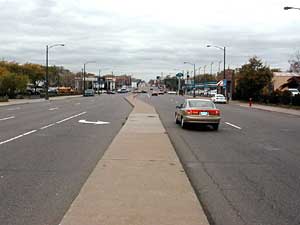|
Audio
Photos
More from MPR
Resources
|
 |
| The 11-mile Central Corridor runs along University Ave. in St. Paul to Washington Ave. in Minneapolis, connecting the two downtowns. (MPR photo/Dan Olson) |
St. Paul, Minn. — Many residents, business people, and local elected officials favor a light rail line along the Central Corridor. But the cost will be a major factor.
The price tag for an 11-mile long Central Corridor light rail line is $840 million. Local officials count on half the money coming from state and local governments, and they hope half will come from the federal government.
The problem is the Federal Transit Administration, which doles out transit money, is pinched because of much higher demand. The FTA has many more applications for transit projects than it has funds.
The agency, observers say, wants requests which show the best results for the lowest cost. That demand is causing Metropolitan Council transportation director Natalio Diaz and his colleagues to look at ways to trim the light rail proposal.
For example they are wondering if a tunnel under the University of Minnesota, costing about $150 million, might be replaced by putting rail lines above ground at a cost of about $30 million.
"It may be necessary, depending on what the calculations come out to be, to take a look at other options," Diaz says.
However, finding right-of-way for the above-ground rail line wouldn't be easy. Kathleen O'Brien, the University of Minnesota's vice president for institutional services, says the U of M has a long-standing preference for a tunnel given all the sensitive experiments going on in labs literally footsteps away from the street.
"The University Board of Regents, as early as the 1930s, passed a resolution asking for the street car along Washington Ave. to be placed in an underground tunnel," she says.
Even so, O'Brien says, the U of M is prepared to consider options.
However, money isn't the only issue.
The Met Council's Diaz says the FTA wants local officials to show a proposed high-speed bus or rail line will be effective, compared to people driving their own vehicles.
"The (FTA wants to see) travel time savings -- things like how many people are going to use the system, what impact the use of that system may have on other things like highway congestion, things like that," Diaz says.
The FTA also casts a critical eye at local zoning codes. The agency wants to fund projects where there's a good chance for success.
|
The (FTA wants to see) how many people are going to use the system, what impact the use of that system may have on things like highway congestion.
- Natalio Diaz, Met Council transportation director
|
Part of the formula for success is development that supports transit. That typically means fairly dense development, with multiple-story housing and businesses friendly to pedestrians, thus more transit riders.
Brian McMahon, director of University United, a development and transit advocacy group in St. Paul's Midway area, says zoning regulations in St. Paul need to be changed. McMahon says current regulations don't allow the kind of development in the Central Corridor the FTA wants to see in an application for money.
"We have single-story, single-use, drive-through buildings that are basically turning their back right at the intersection," McMahon says. There are "no doors or windows. (It's) very incompatible with the kind of environment we need to promote ridership."
McMahon and many others with an interest in the Central Corridor favor light rail over bus rapid transit. The route is already the Twin Cities most heavily used bus service.
An estimate of $240 million for building a bus rapid transit line may sway the final decision. However, the Met Council's Natalio Diaz says surveys consistently show people tend to favor rail.
"It's easier to understand, it's more visible, or that it's a little more comfortable or it's a little more spacious," Diaz says.
At one time the future of the Central Corridor project seemed set. After Hiawatha it was next in line for a transit project. That may still happen, but the landscape at both the federal and state level is changed.
The Federal Transit Administration has raised the bar for ridership numbers. On that basis the I-35W corridor through south Minneapolis to Burnsville moves to the front of the line.
Then, there's cost sharing. The FTA prefers projects with a fatter local funding component. Denver, Phoenix and other cities are able to back up their requests for federal transit money with dedicated sources of local or state transit revenue, a step Minnesota has so far been unwilling to take.





